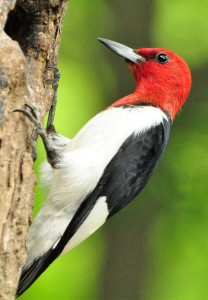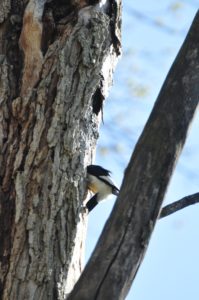Photography courtesy of Lowell Washburn, all rights reserved.
With its crimson head, black and white checkerboard plumage, and bluish chiseled bill; the red-headed woodpecker is one of Iowa’s most strikingly beautiful birds. Occurring statewide, the red-headed is one of the commonest, and certainly one of our most popular, feathered residents. But scientists say the species’ relative abundance may be in peril. Data collected during the North American Breeding Bird Surveys reveals that the number of red-headed woodpeckers is on the wane; declining by an alarming 70 percent across much of its range – including Iowa – since 1966. In Iowa, red-headed woodpeckers suffered a startling 8 percent annual decrease from 1980 to 1994; one of the most dramatic declines listed for any species. Although the rate of decrease has slowed, redheaded woodpeckers will ultimately disappear from many Iowa habitats if current trends continue.
Historically, red-headed woodpeckers were amazingly abundant. At the time of settlement, they were probably America’s commonest woodpecker. During the 1700’s Colonial Era, the birds’ acute fondness for ripening fruit posed an eminent threat to domestic orchards. So much so, that enterprising gunners were paid cash bounties for woodpecker scalps. Human persecution appears to have had little effect, however. More than a half century later, wildlife artist John James Audubon made mention of the species’ unfathomable abundance. In 1840, Audubon noted that 100 red-headed woodpeckers where shot in one day from a single cherry tree. In Iowa, the species’ modern-day populations remained high until the onset of the 1980 crash.
Although no one can pinpoint the exact cause of the woodpecker’s widespread decline, scientists speculate it can likely be attributed to a variety of factors. An ongoing loss of habitat may be an important consideration. Like other woodpeckers, red-headeds need dead or dying trees for nesting. Forest reduction, woodlot removal, flood plain clear cuts, and the removal of dead trees for esthetic purposes are all practices that effectively reduce the number of potential nest sites. There must be more to it though, or other woodpecker species would be experiencing similar declines.
European starlings may be another factor. Starlings are aggressive competitors for remaining nest sites, driving red-headed pairs from tree cavities the woodpeckers have excavated. Although the evidence is circumstantial, increases in starling populations have paralleled a decrease in the number of nesting red-headed woodpeckers across parts of their mutual range.
Red-headed woodpeckers are highly omnivorous, utilizing a wide variety of insects, berries, fruit, and nuts — especially acorns — for a major part of their diet. More so than any other woodpecker, red-headeds are adept at pursuing and catching insects on the fly. Low level hunts often occur where insects concentrate near busy roadways, leading to the greatest vehicle mortality of any woodpecker species. During the 1950s and early ‘60s, it was not uncommon for vehicles to overheat when radiator grills became clogged with the carcasses of Monarch butterflies and road killed red-headed woodpeckers – a sobering reminder of both species’ former abundance in Iowa.
Final Thought: Although red-headed woodpeckers have shown sharp and alarming declines during recent decades, all is not lost. With a bit of searching, this popular summer resident can still be found inhabiting Iowa’s state and county parklands, aging farm groves, and in oak savannahs. Of course, we’ll never again see the abundance witnessed by our Colonial forbearers or noted by John James Audubon; but hopefully we will preserve enough woodland habitat that future generations will be able to observe and enjoy one of Iowa’s most strikingly beautiful songbirds.
LW



 Tom Cope
Tom Cope Sue Wilkinson
Sue Wilkinson Susan Judkins Josten
Susan Judkins Josten Rudi Roeslein
Rudi Roeslein Elyssa McFarland
Elyssa McFarland Mark Langgin
Mark Langgin Adam Janke
Adam Janke Joe Henry
Joe Henry Kristin Ashenbrenner
Kristin Ashenbrenner Joe Wilkinson
Joe Wilkinson Dr. Tammy Mildenstein
Dr. Tammy Mildenstein Sean McMahon
Sean McMahon